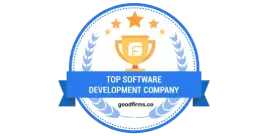Buyer's Guide For Software Development Services

It is undeniable that most of our work is being done using or through software and applications. Your organization is likely already using a couple of them together.
Remember the struggle you went through last time when building one (or are going through right now)?
Even before the first line of the code, there are ‘n’ mountainous questions that need to be answered first,
- Buy it or build it?
- Where to start first?
- Which approach would be more feasible?
- Does your organization really need it, or should it consider an alternative?
And the list continues, with each question leading to the boardroom dilemma — Everyone nods, everyone disagrees! Sounds familiar, right?
Every entrepreneur, especially the startup founders, has gone through this, which is why we have developed this comprehensive guide to streamline your decision-making process regarding software development.
Objectives of This Guide
Before we go any further, below are the objectives that this guide is aiming to achieve -
- What’s software development?
- Solving the Build vs Buy dilemma
- Analyzing the software market
- Types of software
- Benefits of modern software development
- Understanding the software development lifecycle
- Cost estimation and factors affecting the cost of software development
- Top software development companies
- Industry-specific software cost index reference
Fundamentals About Software Development You Should Know
Think of software as a neat and clean set of instructions (aka programs) that tell your system what action to perform. It is the rulebook of machines and is written in programming languages.
At the core, software consists of -
- Code
- Logic
- Algorithms
Hence, the entire software development process, including the cost, revolves around them. NOTE that if you understand three fundamentals about the software, you will probably start to understand,
- How the cost varies as per development,
- What’s the optimum team strength you may require?
And then, if you dive a little deeper, you may also be able to comprehend things like,
- Which tech stack is the best to use?
- Which development methodology should be deployed for optimum results?
On top of this, since comprehending and interacting with a machine only through code is not feasible (or, if we may say, nearly impossible), even for the developers, let alone the regular users. Therefore, we create an interactive and easy-to-use design (UI/UX) that enables interaction with machines through specific software.
It is also essential to mention here a subtle difference between developing software for startups vs enterprises.
Startup Software vs Enterprise Software Development
Although the end user goal of developing software for both startups and enterprises might be the same, the way they are developed is different. Clearly, startups often need softwares that can cater to a specific audience while enterprises target a wide range of user base.
Additionally, there are other natural limiters as well. Startups work under tight budget and team constraints; their journey is full of experiments and evolution, while the same is not true for enterprises.
Enterprises have large teams and proper budget allocation, and they follow a much comprehensive development plan — from ideation to deployment, everything is well-structured with strict adherence to protocols.
To understand more starkly, consider the following case:
“A startup might focus and prioritize on launching MVP and use modern technologies, such as leveraging AI or GenAI for certain parts of development, such as automated QA testing, vibe coding, and low-code/no-code development in their flow. This way, they make use of open-source tools or affordable tools to perform certain parts of their tasks.
On the other hand, an enterprise will primarily focus on developing a full-scale, feature-rich software regardless of the cost.
Here’s how startup software development is different from enterprise-level software development:
| Aspect | Startup Software Development | Enterprise Software Development |
| Objective | Rapid validation of an idea; launch MVP quickly to test market fit. | Build full-scale, stable, and secure software to serve large user bases. |
| Scope | Narrow — focused on a core feature or specific problem. | Broad — multiple modules, integrations, and enterprise-level functionality. |
| Development Approach | Iterative, flexible, and fast-paced (Agile, Lean, or even ad-hoc). | Structured and process-driven (Agile at scale, DevOps, Waterfall hybrids). |
| Technology Stack | Modern, experimental stacks — often leveraging AI, GenAI, or low-code tools for speed. | Mature, proven technologies optimized for reliability, compliance, and scalability. |
| Infrastructure | Cloud-first and cost-efficient (AWS, GCP, Azure pay-as-you-go). | Hybrid or private cloud environments with strict governance and SLAs. |
| Security & Compliance | Basic security with room for improvement; compliance evolves over time. | Rigorous security standards (ISO, SOC 2, GDPR, HIPAA) and regular audits. |
| Testing & QA | Automated testing tools, quick QA cycles, often integrated in CI/CD. | Dedicated QA departments, regression testing, and continuous monitoring. |
| Scalability | Vertical scalability planned later; quick pivot if product-market fit changes. | Designed for horizontal scalability, redundancy, and long-term growth. |
| Maintenance & Support | Reactive — fixes as needed; small updates post-launch. | Proactive — dedicated teams for L1–L3 support, maintenance SLAs, and version control. |
| Risk Tolerance | High — experimentation encouraged; failure = learning. | Low — risk mitigated via policies, governance, and compliance frameworks. |
Analyzing Software Development Market (2025 Status and 2026-30 Status)
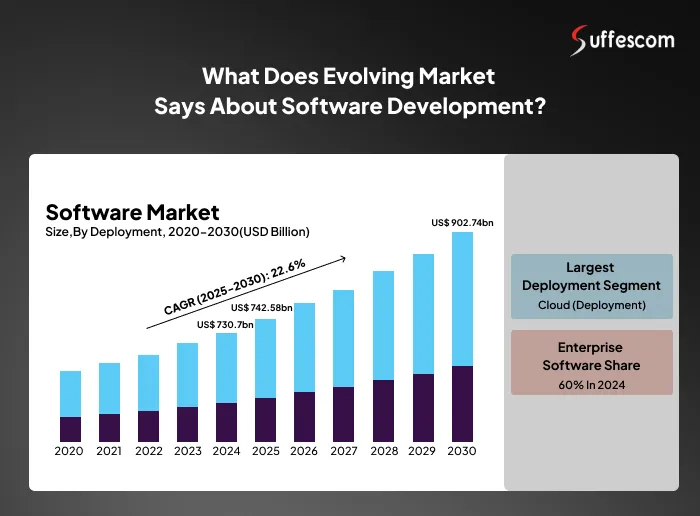
The software market is one of the highest and remarkable growth trajectories with a steady annual growth. Its tangential growth showcases the rising demand in the market, while the steady growth indicates the market stability.
Here are some noteworthy facts (taken from Statista and GrandViewResearch) about the software development market that you should know -
- The Software market is expected to witness a remarkable growth trajectory worldwide.
- It is projected that by the year 2025, the revenue in this market segment will reach an impressive figure of US$742.58bn.
- By type, the enterprise software segment accounted for the largest market share of over 60.0% in 2024.
- By deployment mode, the cloud segment accounted for the largest market share of 57.0% in 2024.
- Additionally, Enterprise Software is anticipated to dominate with a projected market volume of US$316.69bn by 2025.
- Furthermore, the revenue in the Software market is projected to exhibit a steady annual growth rate of 3.98% from 2025 to 2030.
- This growth is anticipated to result in a substantial increase in the market volume, reaching US$902.74bn by the year 2030.
Looking at the anticipations, it is quite normal to think that the next decade will reshape the whole development process and flow! Market studies suggest,
- The development workflow will shift from just coding to AI-assisted coding.
- Rise of low-code/no-code development.
- Vibe coding will take on a significant part of the development process, especially for developing basic features.
- Quantum computing will increase the standards of encryption and advance algorithm fabrication.
- Coding is also going to evolve according to the best environmental practices. Green coding will gain more traction as companies will focus on following environmentally friendly practices
Software development companies that will evolve with the changing trends will be the ones to lead the industry.
15 Core Types of Software Development (Explained)

The software market is evolving at a greater pace. Each of the software types requires a different approach to manage the software development life cycle (SDLC) with varied project steps, roles, responsibilities, collaboration, and communication standards.
Understanding different types of software helps you to have a clear understanding of their purpose and thus allocate your resources effectively when it comes to strategizing the SDLC and hiring software developers.
In this section, we have defined core types of software development, their real-life examples, and common technologies used for each type.
Here are the core software development types, along with their primary purpose and commonly used technologies for them,
| Category | Primary Purpose | Common Technologies |
| Web Development | Online applications | React, Node.js, Django |
| Mobile App Development | Smartphone apps | Swift, Kotlin, Flutter |
| Enterprise Software | Business systems | Java, .NET, Oracle |
| AI/ML Development | Intelligent automation | Python, TensorFlow |
| Cloud Development | Scalable web apps | AWS, Azure, GCP |
| System Software | Hardware control | C, C++ |
| Game Development | Interactive entertainment | Unity, Unreal |
| Blockchain/Web3 | Decentralized systems | Solidity, Rust |
1. Application Software Development
Mobile app development primarily focuses on developing apps that we generally see on our mobile phones. These applications are usually built with a specific end-user goal to boost productivity, communication, or entertainment.
Key aspects about application software development -
- Use multi-platform frameworks for cross-device (iOS and Android) compatibility.
- Relies on API integration to perform a range of tasks, such as payment, user authentication, or analytics.
- CI/CD (Continuous Integration and Continuous Delivery) pipelines reduce time-to-market and ensure regular updates.
- Application telemetry and observability tools (e.g., Datadog, New Relic) enable real-time performance monitoring.
- Programming languages such as Python, Java, Swift, Kotlin, React Native, etc, are used to develop application software.
2. Web Development
Web development focuses on building websites or web-based portals that work on a web browser. It generally includes designing, development, deployment, and database management. Web development mainly works on one simple logic, creating a client-server architecture where the front-end (client-side) interacts with the back-end (server-side) via REST or GraphQL APIs.
Key components of web development include -
- Emphasis on responsive design and mobile-first development for SEO ranking.
- Security measures include HTTPS, JWT, CSP, and input sanitization.
- Uses microservices and containerized deployments for scalability.
- DevOps pipelines automate build, test, and deployment.
- WebAssembly (WASM) is redefining performance for computationally intensive web apps.
- Core technologies include HTML5, CSS3, JavaScript/TypeScript, and frameworks like React, Angular, Vue.js.
3. Desktop Application Software
Desktop applications are the programms that target operating systems like Windows, macOS, or Linux. Desktop software uses computer’s resources such as RAM, graphics card, and processor, which allows them to perform intensive functions and enable higher performance.
Unlike web-based software, they do not require an internet connection to run. Some of the key aspects of the desktop application software are -
- Focuses on local resource management (memory, GPU acceleration).
- Increasing trend toward cross-platform desktop apps using web technologies.
- Allows offline operation and deeper hardware access compared to web apps.
- Integrates with local databases like SQLite or Realm for data persistence.
- Often uses C++, C#, or Java for performance-critical applications.
4. Custom Software Development
Custom software is built to serve a specific purpose of an enterprise or business. Unlike other off-the-shelf software, it usually do not serve the general public purpose. There are certain features that make custom software development a more reliable option for enterprises, such as:
- Built heavily around enterprise workflows and business logic
- Long-Term Maintainability
- Future-Proof Design
- Enterprise-Grade Security
- Seamless Integration
- Performance Reliability
- Full Ownership & Control
- Cloud-Native Scalability
- Data Integrity & Governance
- Resilient Infrastructure
5. API Development
API development consists of writing programms that allow software to communicate with each other. They enable software systems to transfer data and perform specific tasks through pre-defined endpoints, parameters, and data formats.
APIs play a major role in mobile applications. For instance, remember how Uber or Bolt-like apps pick up your exact location through an integrated GPS. These features are enabled through map-based APIs.
In the earlier section (Web development), we talked about front-end and backend interfaces. Well, in those scenarios, APIs play a major role by allowing both the interfaces to interact with each other through APIs.
Key aspects about API development -
- Plays a critical role in third-party integrations and SaaS ecosystems.
- REST and GraphQL dominate modern API paradigms, while gRPC serves high-performance needs.
- Built using frameworks like Express.js, FastAPI, Flask, or Spring Boot.
6. Embedded Software Development
Embedded software is much different than general-purpose software. Unlike computer programs, they contain a specific script that is used by the hardware to perform certain actions.
To develop embedded software, one requires knowledge of low-level programming or assembly language, such as C, to program controllers like Arduino or Raspberry Pi.
Key aspects of embedded software development are -
- Targets specialized hardware with limited computing resources.
- Common in IoT, automotive, robotics, and industrial control systems.
- Uses C, C++, Rust, or Assembly for low-level programming.
- Requires compliance with safety standards like IEC 62304 (medical).
7. Cloud Software Development
Cloud software development is pretty much similar to custom software development that we discussed previously, except that it runs on cloud environments. Instead of using local resources, they utilize cloud services offered by tech giants like Amazon Web Services, Microsoft Azure, or Google Cloud Services.
As the technology is emerging in this digital era, businesses are now preferring cloud software development because of its advantages, like -
- Handles traffic spikes easily and can expand seamlessly.
- Uses common languages such as Python, Java, C#, and JavaScript for serverless computing.
- Enables startups to build and deploy projects without the need to set up a physical infrastructure.
8. Database Development
Database development and management are one of the crucial steps for any software and falls under the category of Database Management System. Databases are used to store data and relations about the organization, website, or software. Modern software usually contains a data system in two types -
- Structured
- Unstructured
Databases mainly comprise the following types -
- Relational Database Management System (RDBMS) - Stores data in rows and columns in tables and follows proper structure. RDBMS uses structured query language (SQL) for data operations and retrieval. Examples include MySQL, PostgreSQL, Oracle Database, etc.
- NoSQL Databases - Primarily used to store large amounts of unstructured or semi-structured data. Due to its nature of storing data, it provides much better scalability and flexibility than RDBMS in certain scenarios.
Although these are the two main types of databases, there are other types as well, with specific use cases.
- In Memory Database
- Object-oriented database
- Cloud databases
9. Game Development
Game development includes a combination of programming, interactive design, and visually appealing graphics to provide an immersive experience for the purpose of entertainment, education, or simulation.
Key aspects of game development are -
- Uses various game engines such as Unity, Unreal, or Godot.
- To provide more immersive and simulated experiences, developers use 3d rendering and physics engines.
- Uses core languages like C++, C#, Python, Lua, etc.
10. Data Science & Machine Learning Development
Data Science and Machine Learning (ML) development focuses on designing intelligent data-driven systems that can autonomously analyze, learn, and optimize outcomes from structured and unstructured datasets.
ML developers work with supervised, unsupervised, and reinforcement learning algorithms, optimizing for accuracy, latency, and explainability (XAI).
These solutions power mission-critical use cases like predictive maintenance, fraud detection, supply chain optimization, and personalization engines.
Key Aspects of data science and machine learning development are -
- Implements supervised, unsupervised, and deep learning paradigms.
- Frameworks: TensorFlow, PyTorch, Scikit-learn, Keras.
- Toolchain: Jupyter, MLflow, Kubeflow, Airflow, DVC.
- Languages: Python, R, Julia.
- Use Cases: Predictive analytics, fraud detection, recommendation engines, demand forecasting.
11. DevOps & Infrastructure Development
DevOps and Infrastructure Development unify software engineering and IT operations to establish continuous delivery pipelines, scalable infrastructure, and automated deployment environments.
It focuses on IaC (Infrastructure as Code) principles, where entire environments are versioned and reproducible using tools such as Terraform, Ansible, or Pulumi.
By implementing CI/CD workflows (GitHub Actions, Jenkins, ArgoCD), teams achieve continuous integration, zero-downtime deployment, and automated rollback.
DevOps engineers orchestrate workloads via Kubernetes and Docker, embed observability layers (Prometheus, Grafana, ELK Stack), and ensure resilience through multi-zone deployment topologies.
Key Aspects of DevOps and Infrastructure development:
- Uses IaC (Infrastructure as Code) with Terraform, Ansible, or Pulumi.
- Establishes CI/CD pipelines via Jenkins, GitHub Actions, GitLab CI, or ArgoCD.
- Employs containerization (Docker) and orchestration (Kubernetes, OpenShift).
- Observability through Prometheus, Grafana, ELK Stack, and Datadog.
- Emphasizes automated rollback, zero-downtime deployment, and horizontal scaling.
12. Blockchain Development
Blockchain development focuses on building distributed ledger systems and decentralized applications (dApps) that eliminate intermediaries and ensure data immutability, auditability, and trustless operations.
Enterprise blockchain solutions rely on smart contracts (developed in Solidity, Rust, or Go) that automate business logic over peer-to-peer consensus protocols like Proof of Stake (PoS) or Practical Byzantine Fault Tolerance (PBFT).
In enterprise environments, blockchain is applied for asset tokenization, cross-border settlements, supply chain traceability, and identity management, where cryptographic security and decentralized governance are paramount.
Key Aspects of Blockchain Development:
- Implements consensus protocols (PoW, PoS, PBFT) for ledger synchronization.
- Develops smart contracts with Solidity (Ethereum), Rust (Solana), or Go (Hyperledger).
- Uses frameworks: Truffle, Hardhat, Web3.js, Ethers.js.
- Integrates with DeFi, NFT, and DAO ecosystems.
- Protocols: Ethereum, Polygon, Avalanche, Hyperledger Fabric.
13. AR/VR Development
Augmented Reality (AR) and Virtual Reality (VR) development involves engineering immersive, spatially aware experiences that merge 3D digital assets with the physical or simulated world.
Developers use real-time rendering engines like Unity3D and Unreal Engine, integrated with ARKit, ARCore, and Vuforia SDKs, to create environments driven by motion tracking, spatial mapping, and sensor data fusion.
AR/VR applications extend beyond entertainment — powering surgical simulations, industrial digital twins, remote training systems, and architectural visualization.
Key Aspects of AR/VR development:
- Built using Unity3D, Unreal Engine, or native SDKs (ARKit, ARCore, Vuforia).
- Integrates motion tracking, 3D modeling, and sensor fusion (IMU, LiDAR).
- Optimized for low-latency rendering and multi-platform XR deployment.
- Applications: Gaming, simulation training, remote collaboration, healthcare visualization.
- Core languages: C#, C++, JavaScript, HLSL/GLSL (for shaders).
14. Cybersecurity Software Development
Cybersecurity software development focuses on building defensive and proactive systems that safeguard digital assets, infrastructures, and identities across distributed environments.
This includes engineering intrusion detection systems (IDS), threat intelligence platforms, endpoint protection solutions, and SIEM frameworks that monitor, correlate, and mitigate threats in real time.
DevSecOps practices are embedded into the SDLC, ensuring continuous vulnerability scanning, static/dynamic code analysis, and secure container deployments.
Key Aspects of cybersecurity software development includes,
- Uses encryption algorithms, pen testing, and vulnerability scanners.
- Tools: Wireshark, Snort, Metasploit, Burp Suite, Splunk.
- Frameworks: Zero Trust Architecture, MITRE ATT&CK, NIST CSF.
- Languages: Python, C/C++, Go, Rust, Bash.
- Focus on secure SDLC, network hardening, and attack surface reduction.
15. Artificial Intelligence Development
Artificial Intelligence (AI) development is the advanced subset of software engineering that focuses on creating self-optimizing, context-aware systems capable of reasoning, perception, and autonomous action.
Unlike traditional ML, AI systems integrate deep learning architectures, transformer-based models, and multimodal intelligence (text, vision, speech) to perform tasks with minimal human input.
Key Aspects:
- Frameworks: TensorFlow, PyTorch, Hugging Face, LangChain, OpenAI APIs.
- Platforms: Vertex AI, Azure Cognitive Services, Anthropic Claude API.
- Languages: Python, Java, Julia, R.
- Deployed in chatbots, autonomous systems, predictive analytics, and intelligent agents.
The Strategic Benefits of Modern Software Development
Each type of software that we discussed in the previous section serves a specific purpose. Software can help you automate repetitive tasks, automate data-heavy tasks, integrate services and work channels, and even provide your customers with an integrated environment.
Though each type of custom-built software addresses certain organization-specific and some trivial goals, here are some of the key benefits of developing custom software.
Workflow Automation
Most of the modern software relies on APIs, which allow it to minimize human intervention and bring fragmented manual workflows under one large umbrella. Organizations can achieve faster throughput with fewer errors and productivity gains through Robotic Process Automation and workflow orchestrations.
| Technical Impact | Outcome |
| Event-driven architecture (EDA) enables real-time system triggers. | Instant task execution and responsive systems. |
| Integration with ERP, CRM, and legacy systems via REST/GraphQL APIs. | Unified data flow across all enterprise systems. |
| Supports asynchronous processing and message queuing (Kafka, RabbitMQ). | Reduced processing latency and improved concurrency. |
| Automated process orchestration through BPMN or Camunda engines. | Streamlined operations with consistent performance across distributed environments. |
Collaborative Work Environment
Custom software development prioritizes integration with the legacy/existing systems, such as databases, CRMs, and ERPs. This integration helps organizations to ensure data consistency across platforms and automate information flow.
This leads to a significant reduction in manual data entry and associated errors, resulting in improved data accuracy and operational efficiency.
| Impact | Outcome |
| Context mapping ensures logical isolation of bounded domains. | Stable system interoperability across modules. |
| Flexible schema design supports evolving data models. | Future-ready data structures with minimal refactoring. |
| API gateways allow adaptive integration without codebase disruption. | Real-time data exchange and synchronization. |
| Federated identity management (SSO, SAML) enables unified access control. | Solutions that evolve with business models, not against them. |
Performance and Efficiency
Custom software is built with the specific performance requirements of your business in mind, including necessary processing speed and scalability. Developers build the software with the full capabilities of your hardware and cloud resources. This ensures the software performs efficiently and reliably, whether handling complex transactions or processing large volumes of data.
| Technical Impact | Outcome |
| Cloud-native architecture with load-balanced microservices. | Stable performance under variable workloads. |
| In-memory caching (Redis, Memcached) and optimized query execution. | Faster response times and reduced I/O overhead. |
| Code-level profiling and runtime optimization for CPU/GPU utilization. | Efficient resource consumption and cost-effective scaling. |
| Asynchronous processing pipelines (Celery, Kafka Streams). | Seamless execution of complex data workflows at scale. |
Competitive Advantage
Custom software serves as a pivotal tool for differentiation in any industry. By offering specialized functionalities finely tuned to your strategic goals, custom development allows you to introduce innovative products or services not readily available in the market.
| Technical Impact | Outcome |
| Domain-driven architecture (DDD) aligns systems with unique business logic. | Tailored functionalities that reflect real operational models. |
| Proprietary APIs, automation rules, and analytics models. | Unique product IP that builds long-term competitive moat. |
| Continuous integration and modular feature rollouts. | Faster innovation cycles and quicker go-to-market. |
| Integration of emerging tech (AI, IoT, Blockchain) via decoupled services. | Sustained market differentiation and adaptability. |
Enhanced Security & Compliance Posture
Custom software enables end-to-end control over data governance, identity management, and encryption protocols, which is critical in regulated industries. Unlike multi-tenant SaaS, it allows enterprises to embed security-by-design principles directly into the SDLC.
| Impact | Outcome |
| Integration of DevSecOps for continuous security validation. | Proactive threat mitigation throughout the development lifecycle. |
| Encryption standards (AES-256, RSA, TLS 1.3). | Robust protection for data at rest and in transit. |
| Compliance alignment with HIPAA, ISO 27001, GDPR, and SOC 2. | Adherence to global regulatory frameworks. |
| Centralized audit logging and role-based access control. | Resilient, compliant systems without third-party exposure. |
Ownership and Full Control
Ownership allows enterprises to govern their own SDLC (Software Development Life Cycle), prioritize high-impact features, and align the engineering backlog directly with business KPIs and operational SLAs. It also simplifies technical debt management, as updates, refactoring, and modernization can occur on your own terms, maintaining long-term system integrity.
| Technical Impact | Outcome |
| Full access to source code, infrastructure, and version control. | Complete autonomy over evolution and maintenance. |
| Internalized DevOps pipelines for release governance. | Customizable deployment cycles aligned with business priorities. |
| Architecture refactoring and modernization on-demand. | Sustainable system integrity and reduced long-term costs. |
| Proprietary IP enables potential for productization or white-labeling. | Transforms technology from operational expense to strategic asset. |
Scalability and Agility
Unlike off-the-shelf systems that require disruptive upgrades or version-dependent patches, custom-built platforms evolve through incremental scaling, load balancing, and continuous deployment pipelines, ensuring operational continuity even during expansion phases.
Custom systems can be quickly realigned with emerging market dynamics, compliance updates, or technology shifts (such as AI integration, new APIs, or platform migrations).
| Technical Impact | Outcome |
| Horizontal scaling and auto-scaling policies (AWS ECS, Azure AKS). | Seamless expansion without downtime. |
| Load balancing and distributed caching strategies. | Consistent performance under high demand. |
| Continuous integration pipelines enable adaptive releases. | Faster feature delivery in dynamic markets. |
| Modular microservice design supports independent scaling. | Future-proof architecture adaptable to new technologies and regulations. |
Understanding Software Development Life Cycle (SDLC)
The Software Development Life Cycle (SDLC) is the structured framework that governs how software is planned, designed, engineered, tested, and maintained.
For enterprises, the SDLC functions as a technical blueprint and governance model, ensuring that every stage of development aligns with business objectives, compliance standards, and long-term system reliability.
Unlike traditional linear models, modern SDLC frameworks integrate DevOps, Agile, and CI/CD practices, enabling continuous delivery and iterative improvement. This ensures not only faster releases but also traceability, version control, and defect prevention, which are essential for regulated software environments.
Key technical characteristics include:
- Modularity and Reusability: Promotes componentized design using microservices or SOA (Service-Oriented Architecture) for scalable development.
- Automation: Embeds CI/CD, automated testing, and IaC (Infrastructure as Code) for continuous reliability.
- Traceability: Implements version control, documentation, and requirement mapping via tools like Git, Jira, and Confluence.
- Security Integration: Adopts DevSecOps for security validation at every phase — from code review to deployment.
- Observability: Ensures system health through metrics, logging, and tracing with Prometheus, Grafana, and OpenTelemetry.
The complete Software Development LifeCycle consists of the following stages -
| SDLC Phase | Description |
| 1. Requirement Analysis | The foundation of the SDLC — teams gather and document functional, non-functional, and regulatory requirements. Involves stakeholder interviews, data flow analysis, and defining KPIs, SLAs, and acceptance criteria. Tools: Jira, Confluence, Figma, UML modeling. |
| 2. System Design & Architecture | Architects translate business logic into technical blueprints — defining architecture style (monolithic, microservices, serverless), database schema, API strategy, and infrastructure provisioning. Emphasizes scalability, redundancy, and performance optimization. |
| 3. Development (Implementation) | The actual coding phase where developers build modules per design specifications. Involves CI/CD pipelines, code versioning (Git), API integrations, and infrastructure automation (Terraform, Docker, Kubernetes). |
| 4. Testing & Quality Assurance | Verifies that the system meets functional and security standards. Involves unit, integration, regression, and penetration testing using automated suites (Selenium, JMeter, Postman). QA also validates compliance requirements (e.g., HIPAA, ISO 27001). |
| 5. Deployment | Software is moved to the staging and production environments. Uses continuous deployment, container orchestration (Kubernetes), and blue-green or canary releases to ensure zero downtime. Deployment pipelines integrate rollback and observability triggers. |
| 6. Monitoring & Maintenance | Continuous monitoring of application performance (APM), security posture, and user analytics. Uses Prometheus, Grafana, Dynatrace, or New Relic for health metrics. Maintenance includes version updates, bug fixes, and performance tuning. |
| 7. Feedback & Iteration | Incorporates user feedback, analytics insights, and system telemetry into iterative improvements. In Agile environments, this feeds into backlog grooming and continuous product optimization. |
| 8. Documentation & Compliance | Ongoing documentation of codebase, architecture decisions, security policies, and deployment workflows to ensure audit readiness and operational traceability. |
Code, Process, and Flow – Software Development Methodologies
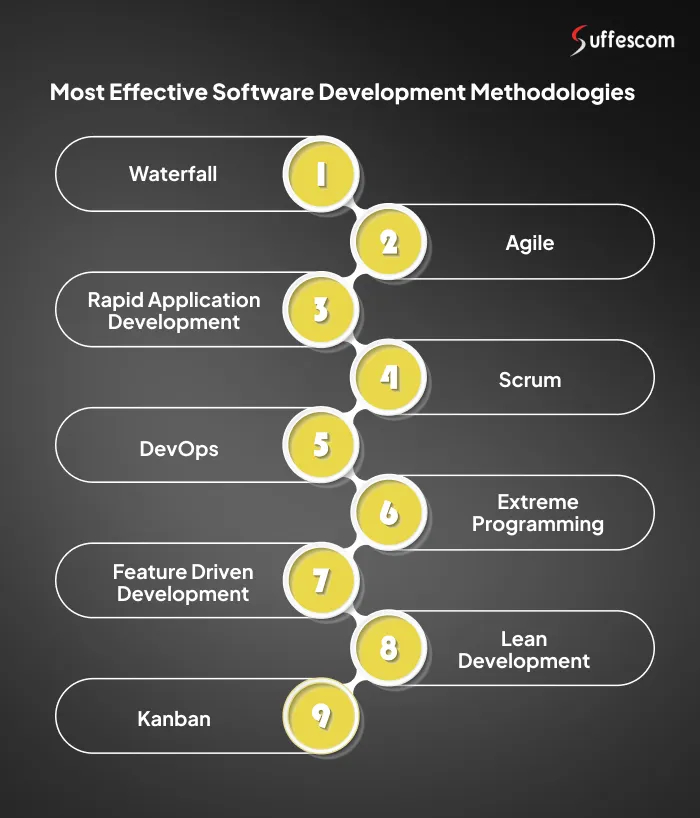
The Software Development Methodology (SDM) defines the framework or philosophy that governs how teams plan, build, test, and deploy software.
Modern development methodologies are not one-size-fits-all. Enterprises often blend approaches by balancing predictability and compliance (Waterfall, V-Model) with agility and innovation (Agile, DevOps).
Understanding each methodology’s technical foundation, workflow cadence, and collaboration model is essential for designing scalable and maintainable software ecosystems.
Different methodologies determine:
- Architecture Flexibility - whether design is fixed upfront (Waterfall) or adaptive (Agile, Spiral).
- Feedback Integration - how frequently feedback loops inform iteration.
- Automation and CI/CD Adoption - extent of integration between development, testing, and deployment.
- Governance and Documentation Depth - degree of traceability, compliance, and audit control.
- Resource Coordination - team autonomy, cross-functionality, and communication workflows.
Below are some of the highly effective methodologies that enterprises and startups often use,
| Methodology | What is it? |
| Waterfall Model | A linear, phase-gated model where each stage (requirements → design → development → testing → deployment) is completed sequentially. Ideal for projects with well-defined requirements, minimal change tolerance, and strict regulatory compliance (e.g., healthcare, aerospace). |
| Agile Methodology | Encourages adaptive planning, rapid feedback, and continuous improvement. Enables CI/CD pipelines, automated testing, and cross-functional collaboration through frameworks like Scrum and Kanban. |
| Scrum Framework | A subset of Agile that structures development around short iterations (sprints) and daily stand-up meetings. Employs artifacts such as product backlogs, sprint planning, and retrospectives. |
| Kanban Model | Focuses on visual workflow management to maximize flow efficiency. Tasks are represented on boards (physical or digital) to track status from “To Do” to “Done.” |
| Lean Development | Rooted in lean manufacturing principles, this model aims to eliminate waste, maximize value, and deliver faster. Prioritizes MVP (Minimum Viable Product) releases, iterative validation, and efficiency-driven coding practices. |
| DevOps Model | Integrates development and operations through automation, continuous monitoring, and rapid delivery pipelines. Promotes IaC (Infrastructure as Code), CI/CD, and observability. Ensures continuous integration, testing, and deployment. |
| Spiral Model | Each phase includes risk analysis and refinement, making it suitable for large, high-risk projects (defense, R&D systems). |
| V-Model (Verification & Validation) | An extension of Waterfall emphasizing parallel testing and validation at each development stage. For every development phase (design, code, build), there’s a corresponding testing phase (unit, integration, system). |
| Rapid Application Development (RAD) | Focused on prototyping and user feedback loops rather than rigid planning. Leverages low-code/no-code platforms, component reuse, and time-boxed iterations to deliver faster outcomes. |
| Extreme Programming (XP) | A highly disciplined Agile methodology emphasizing code quality and responsiveness to change. Practices include pair programming, test-driven development (TDD), and continuous integration. |
Comparing Agile vs Waterfall vs DevOps Software Development Methodology
| Aspect | Waterfall | Agile | DevOps |
| Approach | Sequential | Iterative | Continuous |
| Flexibility | Rigid once defined | Highly adaptable | Continuous feedback and automation |
| Documentation | Heavy upfront documentation | Lightweight, ongoing | Automated documentation integrated into pipelines |
| Testing | After the development phase | Continuous | Continuous and automated |
| Delivery | Single release | Incremental sprints | Continuous integration and delivery |
| Best For | Regulated or fixed-scope projects | Dynamic product evolution | Scalable, always-on enterprise systems |
| Core Tools | MS Project, Jira (tracking) | Jira, Trello, Slack | Jenkins, GitLab, Terraform, Kubernetes |
Inside the Software Tech Stack - Languages, Frameworks, and Platforms
You might have heard geeks and developers talking about the tech stack! Well, to understand this, let’s break down the term “tech stack - a stack of tech”. And this is exactly what it means.
To build software, you may need to use a combination of multiple programming languages along with various frameworks, depending on the product you are building. This combination of technologies, or per se a stack of technologies, is the software tech stack.
Below are some of the most used technologies and frameworks for custom software development. Have a look at them (a heads-up: do not get overwhelmed seeing these numerous complex terms. If you need clarification on any of them for your project, please let us know!),
| Category | Technologies / Platforms / Frameworks |
| Programming Languages | Java, C, C++, C#, Python, JavaScript, TypeScript, PHP, Ruby, R, Rust, Swift, Objective-C, Kotlin, Go (Golang), Scala, Dart, Elixir, Julia, Perl |
| Web Frameworks & Libraries | React, Angular, Vue.js, Svelte, Next.js, Nuxt.js, Gatsby, jQuery, Bootstrap, Tailwind CSS, ASP.NET, Blazor, Spring, Django, Flask, FastAPI, Ruby on Rails, Laravel, Symfony, CodeIgniter, Express, NestJS, Fastify, Ktor, Meteor.js, Medusa.js, Strapi, GraphQL, Apollo, Redux, RxJS, Zustand |
| Mobile Technologies | React Native, Flutter, Kotlin Multiplatform (KMP), SwiftUI, .NET MAUI, Xamarin, Ionic, Capacitor, Jetpack Compose, Unity, Unreal Engine |
| Cloud Computing & Infrastructure | Microsoft Azure, Amazon Web Services (AWS), Google Cloud Platform (GCP), Oracle Cloud Infrastructure (OCI), IBM Cloud, Cloudflare, DigitalOcean, Heroku, Vercel, Netlify, Red Hat OpenShift, Alibaba Cloud |
| DevOps, CI/CD & Infrastructure Automation | Docker, Podman, Kubernetes, Helm, Terraform, Ansible, Pulumi, Jenkins, GitLab CI, GitHub Actions, ArgoCD, CircleCI |
| Monitoring, Logging & Observability | Prometheus, Grafana, ELK Stack (Elasticsearch, Logstash, Kibana), Datadog, New Relic, Dynatrace, OpenTelemetry |
| Containerization & Serverless Platforms | Docker, Kubernetes, AWS Lambda, Azure Functions, Google Cloud Run, Knative, OpenFaaS |
| API Management & Integration | Kong, Apigee, AWS API Gateway, MuleSoft, Azure API Management, Postman |
| Data Processing & Streaming | Apache Kafka, Apache Spark, Flink, RabbitMQ, Celery |
Post-Launch Checklist for Making Your Sustainable Software
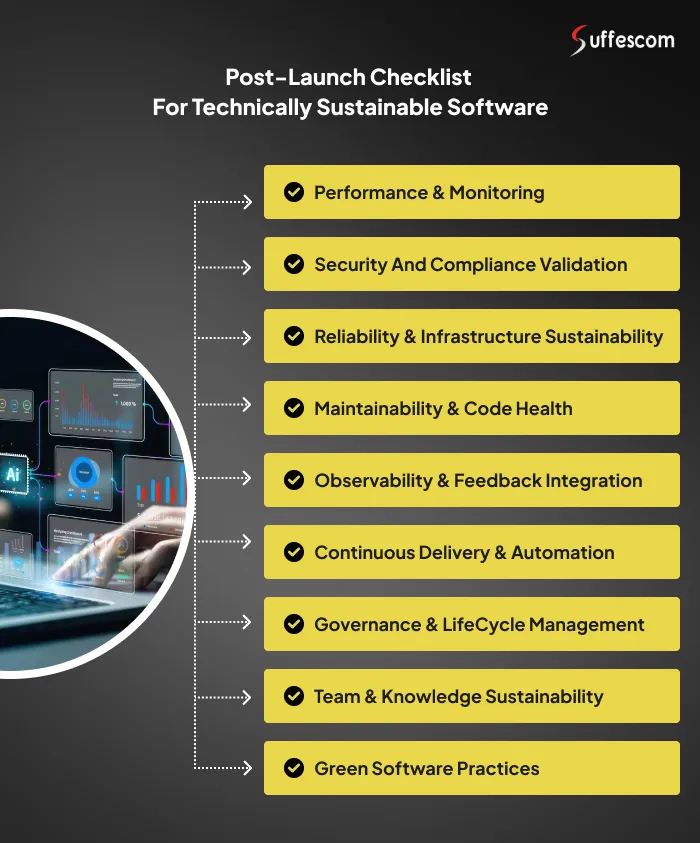
Calculating the Custom Software Development Cost
When calculating the cost to develop custom software, several factors play a role. Before jumping directly to the cost numbers, let us understand what the factors are that determine the cost.
Software Development Cost Deciding Factors
1. Scope & Complexity
One simple way of understanding the breadth of the software is to calculate the entire module in terms of the number of pages. Generally speaking,
- A small software may have between 10 and 25 pages.
- A mid-level software usually has between 25 and 40 pages.
- An enterprise-level software may have 40+ pages to develop.
In short, more logic, more lines of code, higher cost.
Cost of Hiring Developers
The type of developers you hire for your software development also impacts the cost. Depending on the tech stack, actual rates of hiring a software developer might vary; however, a general hourly rate estimation is given below.
| Role | Hourly Rate |
| Hire dApp Developer | $26–$32 |
| Hire Ethereum Developer | $28–$33 |
| Hire Smart Contract Developer | $27–$30 |
| Hire Core Blockchain Developer | $26–$28 |
| Hire Swift Developer | $26–$27 |
| Hire Rust Developer | $29–$32 |
| Hire AI Developer | $32–$38 |
| Hire Kotlin Developer | $28–$31 |
| Hire Casino App Developer | $26–$28 |
| Hire Solidity Developer | $27–$31 |
| Hire Web3 Developer | $26–$31 |
| Hire MEAN Stack Developer | $31–$36 |
| Hire React.js Developer | $26–$28 |
| Hire NFT Developer | $33–$38 |
| Hire React Native Developer | $26–$31 |
| Hire Hybrid Blockchain Developer | $27–$30 |
| Hire Metaverse Developer | $32–$35 |
| Hire Crypto Exchange Developer | $35–$38 |
2. Technology Stack
Your choice of programming languages, frameworks, and infrastructure directly impacts cost. Latest frameworks and integration of AI/ML automation workflows increase the developmental cost significantly.
3. Architecture Design
Monolithic systems (a single software application with all its components integrated in one place) are faster and cheaper to build initially, but harder to scale. Microservices (a combination of multiple tech stacks) or serverless architectures cost more upfront but reduce future technical debt and operational overhead.
4. Integration Requirements
Connecting with external systems (CRMs, ERPs, payment gateways, IoT, APIs) adds data-mapping, validation, and security layers. These external systems are often integrated with the help of APIs, which increases both development and QA time, thereby increasing the cost.
5. UI/UX Complexity
Custom interfaces, animation-rich dashboards, and accessibility compliance (WCAG, ADA) require more design and front-end development cycles, thus naturally increasing the overall cost of software development.
6. Security & Compliance
Implementing security-by-design, encryption, access control, and standards like HIPAA, GDPR, or SOC 2 increases engineering hours, documentation, and audit scope. Here’s brief overview of the cost implications of various security compliance and certifications,
| Compliance Standard | Applicable Domain | Additional Cost (%) |
| HIPAA | Healthcare / MedTech | +15–25% |
| GDPR | EU-based operations | +10–15% |
| SOC 2 | SaaS / Cloud | +10–20% |
| ISO 27001 | Enterprise security | +10–15% |
| PCI DSS | FinTech / eCommerce | +15–20% |
7. Team Composition & Expertise
The size, experience level, and geographic distribution of your team determine labor cost.
Senior engineers, DevOps, or architects increase hourly rates but enhance stability and delivery quality.
8. Deployment Infrastructure
Cloud-native, hybrid, or on-prem environments have distinct cost implications for setup, hosting, CI/CD pipelines, and ongoing operations.
9. Testing & Quality Assurance
Automated test coverage, performance benchmarking, and regression testing increase short-term cost but reduce long-term maintenance expenses.
10. Maintenance & Scalability
Post-deployment maintenance — bug fixes, version upgrades, and performance tuning — typically accounts for 15–25% of annual software cost.
Future-proof, modular design can lower these recurring expenses significantly.
Estimated Cost of Developing a Custom Software
| Software Type | Estimated Development Time | Approx. Cost Range (USD) | Key Specs |
| Basic Software / MVP | 2–4 months | $20,000 – $50,000 | Monolithic architecture, single platform, limited API integration |
| Moderate Complexity App | 4–6 months | $50,000 – $150,000 | REST/GraphQL APIs, relational database, responsive UI, moderate automation |
| Enterprise-Grade Application | 6–12 months | $150,000 – $400,000 | Microservices, CI/CD, cloud-native deployment, RBAC, automated QA |
| Complex SaaS / Multi-Tenant Platform | 9–15 months | $300,000 – $800,000 | Multi-tenant architecture, containerization (Kubernetes), DevOps, advanced security |
| Regulated / High-Security Systems | 12–18 months | $400,000 – $1,000,000+ | Compliance (HIPAA, SOC 2, ISO 27001), encryption, audit logging, load balancing |
| AI / ML-Powered Software | 9–18 months | $250,000 – $700,000+ | AI/ML pipelines, data engineering, GPU workloads, model training & integration |
| IoT / Embedded System Software | 10–16 months | $300,000 – $800,000+ | Real-time data streaming, MQTT/CoAP, firmware integration, security layers |
*Note that these are estimations of the total cost; actual cost, however, may vary!
If you are looking for an industry-specific software cost index reference to know how much different types of software, like ERP software, healthcare software, CRM software cost, refer to the resource section at the end of this e-guide.
Now since we have talked about the rough estimation of the development cost of a custom software, it is important for you to have an idea about the team structure who will be collaborating on a typical software development.
Software Development Team Structure - Ideal Approach
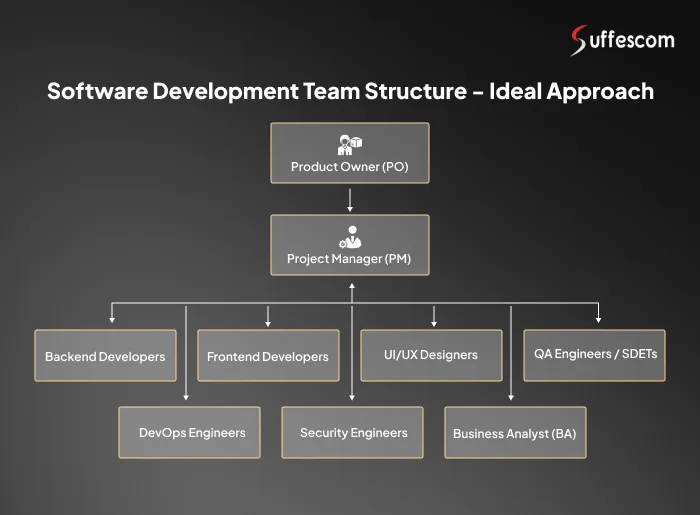
Top Software Development Companies to Partner With
Now that you have a complete idea about the software development process, its methodologies, and team structure, it's time to look at major software development companies you can partner with for your next custom software build.
We have curated this list after careful consideration of key parameters such as their active years, client reviews, expertise, and Clutch ratings.
1. Suffescom Solutions
| Founded In | 2013 |
| Headquarters | USA (with offices globally) |
| Company Size | 250+ Employees |
| Clutch Rating | 4.9 |
| Minimum Project Size | US $25,000+ |
| Hourly Rate | US $25 – 49 / hr |
About the company
Suffescom is a leading software development company with over 11 years of professional experience. They provide custom and white-label IT solutions. With a strong presence in the software development market of the Middle East and the UK, the company deploys an agile development framework with close iteration with clients to deliver quality work.
Core Expertise
- Blockchain Technology
- Artificial Intelligence
- Mobile app development
- Web development
- Custom Enterprise Software
- E-Commerce and On-Demand Solutions
- Healthcare, Finance, and Banking
- Software Development Services
- Automotive and Logistics
Industries Served
Suffescom has over 12 years of experience in providing core IT services globally. They have diverse experience across e-commerce, food delivery, NFTs, Gaming, SaaS, entertainment, and Agentic AI.
They have partnered with several renowned brands to provide services such as StealthEX, Chillis, Radisson Hotels, Universal, and NBC.
Client Testimonials
"Suffescom Solutions Inc excels in delivering high-quality and innovative solutions."
— Robert, Technical Analyst, Marqade
"Suffescom Solutions Inc's ability to combine technical excellence with genuine collaboration stood out."
— Shelton Pounce, CTO, Sun Shine Ride Share
2. RisingMax Inc
| Founded In | 2011 |
| Headquarters | New York, NY, United States |
| Company Size | 10 – 49 Employees |
| Clutch Rating | 5.0 (43 Reviews) |
| Minimum Project Size | US $10,000+ |
| Hourly Rate | US $50–99 / hr |
About the Company
RisingMax is a premier agile software development company based in New York, renowned for delivering high-performance, scalable, and innovation-driven digital solutions. Since 2011, the company has provided services to startups and enterprises with agile methodologies, including Scrum, sprint-based development, Lean development, Scrumban, and Kanban frameworks.
Core Expertise
RisingMax specializes in:
- Custom Software Development
- Web & Mobile App Development
- Enterprise-Grade Agile Solutions
- E-Commerce and SaaS Development
- Agentic AI Development
- Blockchain & Web3 Solutions (NFT Marketplaces, Crypto Exchanges, Blockchain Games)
Industries Served
The company has successfully delivered 1000+ projects across sectors such as healthcare, IT services, e-commerce, fintech, entertainment, and blockchain. Their agile-driven approach enables businesses in diverse domains to scale efficiently and innovate rapidly.
Client Testimonials
“We hired RisingMax for AWS Consulting & Migration for the NFT Marketplace. Their experience shines through their way of working.” — Nathan Cable, CTO, My Rare Collection
“Their passion for providing impeccable services to their clients is the most impressive attitude of the company.” — Steven Hawkins, Manager, Bigtechsolutions
3. HyperLocal Cloud
| Founded In | 2020 |
| Headquarters | New York, NY, United States |
| Company Size | 50–249 Employees |
| Minimum Project Size | US $25,000+ |
| Hourly Rate | US $25–49 / hr |
Primary services
- Mobile App Development
- Web Development
- Custom Software / Enterprise Solutions
- E-Commerce / Marketplace Platforms
- Cloud / Backend Solutions (Java, Python, .NET, Node.js)
Industries Served
They have successfully completed projects with clients in delivery, on-demand services, retail, eCommerce, logistics, and healthcare niches.
The development agency provides services in industries like logistics, Healthcare, Rental, Food, Grocery, and service marketplaces.
Previously, they have worked on Just Ryde (a ride-sharing on-demand app) and served renowned clients such as Kucher, Mealed, Realting, and others.
Technologies & Frameworks
HyperLocal Cloud leverages modern frameworks like React Native, Node.js, Java, and Python, combined with cloud infrastructure on AWS and Google Cloud, to build high-performance hyperlocal and multi-vendor marketplace platforms.
Client Testimonials
“We needed an online delivery app with separate panels for customers, delivery agents, admin & restaurants. Our aim was not to compromise on app reliability and efficiency; that is exactly what we got delivered.” — Eat Delivery.
“Hyperlocal Cloud has been one of the best app solution providers. They made it absolutely easier to operate my online food delivery app, from effortlessly browsing through menus to tracking deliveries in real-time." — Mealed
Other clients have highlighted their project management, cost-effectiveness, and fast-to-market workflows.
Choosing Software Development Companies? Here’s A Checklist to Follow
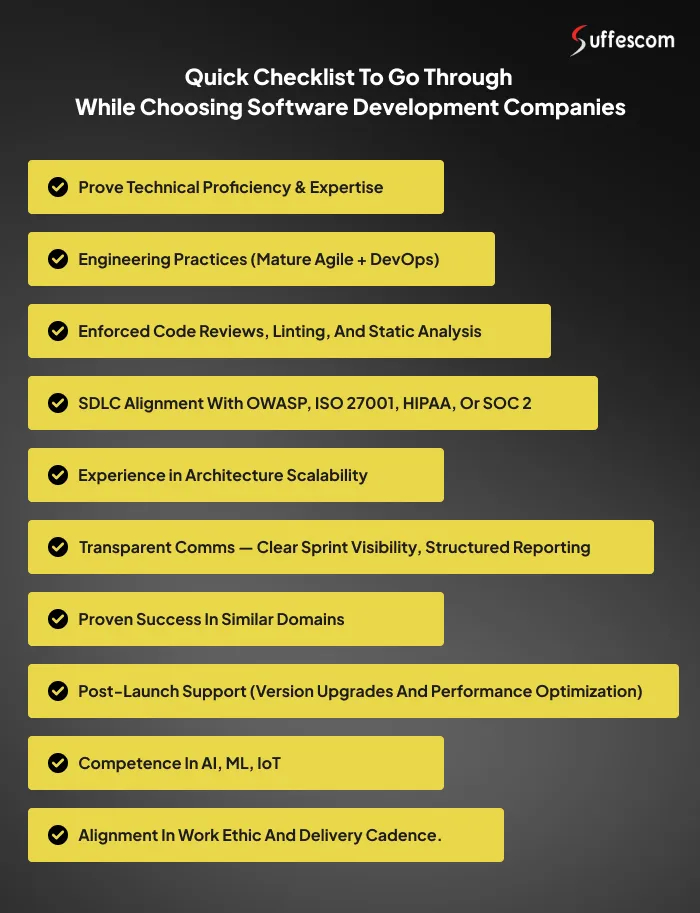
Industry-specific Software Cost Index Reference (Real-Cost Reference)
| Industry / Software Type | Estimated Development Cost (USD) | Technical Scope Highlights |
| Healthcare Software Cost | $180,000 – $300,000 | HIPAA compliance, EHR/EMR integration, HL7/FHIR APIs, telemedicine modules |
| Financial / FinTech Software Cost | $150,000 – $400,000 | PCI DSS compliance, transaction engine, risk scoring, API-based banking |
| Insurance (InsurTech) Software Cost | $120,000 – $250,000 | Claim automation, underwriting workflows, predictive analytics |
| Retail / POS Software Cost | $60,000 – $150,000 | Inventory sync, POS integration, loyalty & billing systems |
| eCommerce Software Cost | $80,000 – $200,000 | Multi-vendor marketplace, headless CMS, advanced search & personalization |
| Educational (EdTech) Software Cost | $70,000 – $180,000 | LMS integration, video streaming, assessment automation |
| Tourism / Travel Software Cost | $90,000 – $200,000 | Booking engine, payment gateway, real-time API integrations |
| Real Estate / PropTech Software Cost | $100,000 – $250,000 | Property listings, 3D tours, CRM, valuation & GIS mapping |
| Logistics / Supply Chain Software Cost | $120,000 – $300,000 | Fleet tracking, WMS/TMS integration, route optimization, IoT sync |
| Manufacturing / Industrial Software Cost | $150,000 – $350,000 | MES/ERP integration, IoT, predictive maintenance dashboards |
| Energy / Oil & Gas Software Cost | $200,000 – $500,000 | SCADA integration, analytics, regulatory compliance modules |
| Government / Public Sector Systems Cost | $180,000 – $400,000 | Secure citizen portals, workflow automation, eGovernance APIs |
| Telecom / OTT / Media Platform Cost | $200,000 – $450,000 | Subscription management, content streaming, analytics |
| HRMS Software Cost | $50,000 – $120,000 | Payroll, performance, compliance automation |
| CRM Software Cost | $60,000 – $150,000 | Pipeline tracking, automation, third-party API integrations |
| ERP Software Cost | $120,000 – $300,000 | Multi-module resource planning, financial and HR integration |
| Accounting Software Cost | $50,000 – $100,000 | Invoicing, taxation, reporting, reconciliation |
| MarTech / Marketing Automation Cost | $60,000 – $150,000 | Campaign automation, segmentation, analytics, CRM integration |
| Email Marketing Platform Cost | $40,000 – $90,000 | Template builder, tracking, SMTP delivery, analytics |
| Project Management Software Cost | $70,000 – $150,000 | Kanban, Gantt, resource allocation, API-based workflows |
| Visual Website Builder / CMS Cost | $50,000 – $100,000 | Drag-drop UI, templates, headless CMS architecture |
| Food Delivery / On-Demand Platform Cost | $100,000 – $250,000 | Multi-user app, GPS tracking, order management, live notifications |
| Super App Development Cost | $250,000 – $600,000 | Multi-service integration, modular architecture, microservices |
| AI/ML Software or Integration Cost | $80,000 – $300,000 | NLP/vision models, predictive analytics, MLOps pipelines |
| Blockchain / Web3 Software Cost | $120,000 – $400,000 | Smart contracts, dApp, decentralized authentication |
| Multi-Payment Gateway Integration Cost | $20,000 – $50,000 | PCI compliance, gateway SDKs, fraud detection |
| GPS & Navigation Integration Cost | $20,000 – $50,000 | Real-time map sync, geofencing, fleet routing |
| IoT / Smart Device Platform Cost | $150,000 – $400,000 | Edge computing, MQTT, cloud sync, firmware integration |
| LegalTech Software Cost | $100,000 – $250,000 | Document automation, compliance workflow, case tracking |
| RegTech Platform Cost | $150,000 – $350,000 | Risk modeling, KYC/AML automation, policy audit systems |
| PropTech / Smart Real Estate Platform Cost | $120,000 – $280,000 | Digital twin integration, property analytics, AR/VR view |
| Gaming / Entertainment Platform Cost | $200,000 – $500,000+ | Real-time engines, AR/VR, multiplayer networking |
FAQs for Software Development
1. What is the first step in the software development process?
The software development process starts with requirement analysis, where business needs, user goals, and system specifications are gathered to form the project scope. This phase defines the SDLC blueprint and influences cost, timeline, and tech stack decisions.
2. How do I decide between custom software vs. off-the-shelf solutions?
Choose custom software development if your business needs scalability, integrations, or security compliance. Go for off-the-shelf software for short-term, low-cost use cases. The build vs buy decision depends on your workflow complexity, compliance requirements, and total cost of ownership.
3. How long does enterprise-level software development usually take?
An enterprise-grade software project typically takes 6 to 12 months, depending on scope, integrations, and compliance. MVPs can be delivered in 3–4 months, while AI- or SaaS-based systems may extend beyond 15 months for full deployment.
4. What are the main stages of the Software Development Life Cycle (SDLC)?
The SDLC includes requirement analysis, design, development, testing, deployment, and maintenance. Modern models also add feedback loops and DevSecOps validation to ensure security, compliance, and scalability throughout.
5. How much does custom software development cost in 2025–26?
The average software development cost ranges between $50,000–$400,000 depending on features, architecture, and compliance scope. AI/ML-powered and regulated systems may exceed $800,000, factoring in data engineering and audit certifications.
6. Which software development methodology is best for my business?
If you prioritize speed and flexibility, go with Agile or DevOps. For compliance-heavy or fixed-scope projects, Waterfall or V-Model works best. Many enterprises adopt hybrid Agile-DevOps to balance innovation with process governance.
7. What factors most impact software development cost?
Cost is driven by scope, team expertise, tech stack, integrations, and compliance needs. Architecture complexity (e.g., microservices vs. monolithic), UI/UX requirements, and testing coverage also directly affect overall budget and timelines.
8. How can I ensure security and compliance in enterprise software?
Embed DevSecOps practices from day one. Implement AES-256 encryption, RBAC, secure APIs, and maintain compliance with HIPAA, GDPR, SOC 2, or ISO 27001. Continuous security validation during SDLC is critical for regulated industries.
9. How do startups and enterprises differ in software development?
Startups focus on speed, MVP validation, and cost-efficiency, often using low-code and cloud-first solutions. Enterprises emphasize stability, compliance, and scalability, with dedicated QA, DevOps, and audit workflows.
10. What tech stack should I choose for custom software development?
Your tech stack should align with performance and scalability goals. Common choices include React or Angular for frontend, Node.js or Python for backend, and AWS or Azure for cloud infrastructure. Architecture (microservices, serverless) defines long-term agility.
11. What is the role of AI and automation in modern software development?
AI is transforming software engineering through AI-assisted coding, automated QA testing, predictive maintenance, and DevOps orchestration. Tools like GitHub Copilot and ML-powered CI/CD pipelines reduce time-to-market and improve delivery quality.
12. What are common mistakes to avoid in software development projects?
Avoid unclear requirements, scope creep, lack of documentation, and poor communication. Also, skipping QA automation or security testing early often leads to costly post-launch rework and performance issues.
13. How can enterprises future-proof their software investments?
Use modular architectures, API-first design, and cloud-native scalability. Adopt CI/CD pipelines for continuous delivery and monitor performance via APM and observability tools like Prometheus or Grafana. Always plan for tech stack modernization.
14. What should I look for in a software development company?
Evaluate partners by their technical expertise, communication transparency, delivery cadence, compliance experience, and client portfolio. Check Clutch ratings, project success rate, and their approach to Agile delivery and post-launch support.
15. Why is post-launch maintenance crucial for custom software?
Post-launch maintenance ensures performance optimization, security patching, and feature evolution. Continuous monitoring, version control, and data analytics help maintain stability, improve UX, and align software with changing business needs.






